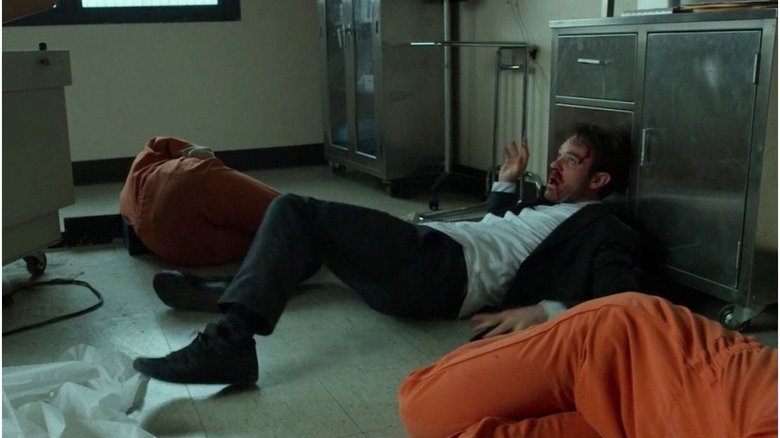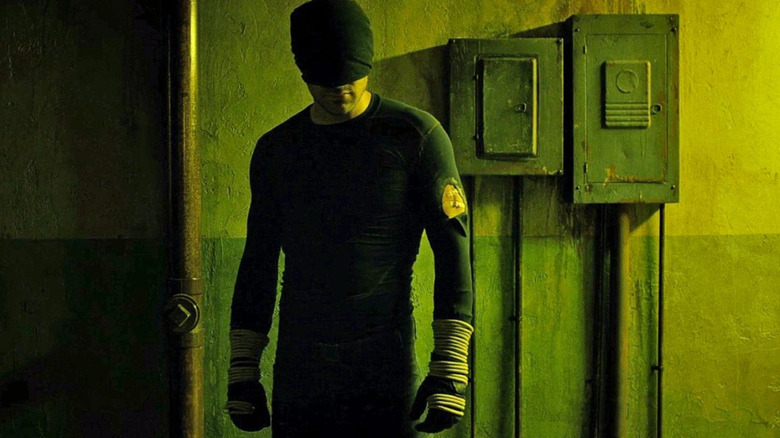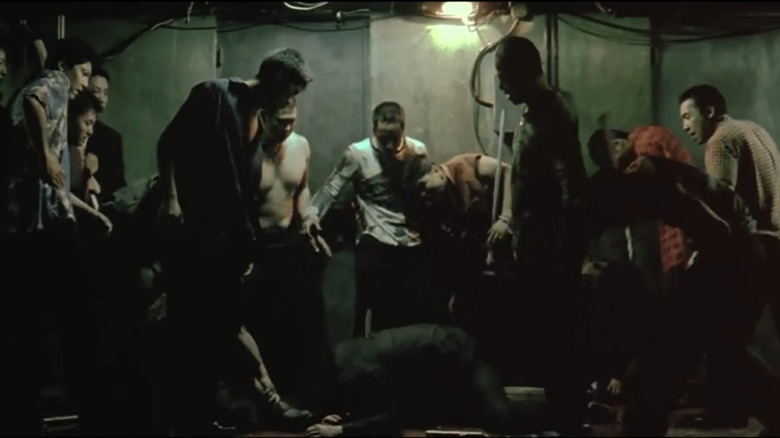Daredevil's Famous One-Take Fight Scene Was A Tough Sell To Marvel Execs
One of the most famous scenes from Netflix's "Daredevil" is the conclusion of season 1, episode two, "Cut Man." Daredevil/Matt Murdock (Charlie Cox) takes on multiple men at once to rescue a kidnapped child. The five-minute scene takes place in a single hallway and an adjacent room and was a one-take shot, or "oner." The scene earned considerable praise for its choreography and camera work; the green saturation and heavy shadows don't hurt the atmosphere, either.
Both subsequent "Daredevil" seasons tried to one-up the "Cut Man" oner with a longer, more complex one-take action beat. Season 2, episode three, "New York's Finest," features Daredevil marching through a stairwell while railing on a biker gang. Season 3, episode four, "Blindsided," took things to another level, with a sequence of Matt Murdock struggling for his life through a prison; this oner lasted just under 11 minutes. It goes without saying that this scene required intense choreography and careful staging, given it was a one-take action scene that moved through multiple locations. Even the Marvel bigwigs weren't initially convinced it could be done.
Executing the scene
Vulture published an oral history of the season 3 prison scene's conception and execution in 2018, shortly after the season premiere. Interviewees included showrunner Eric Oleson, Tom Lieber, Marvel Television VP of original programming, and "Blindsided" director Alex Garcia Lopez.
The initial idea for the "oner" was Garcia Lopez's; it came to him while reading the episode script:
"It just kept yelling at me, 'This should be a oner.' I... called Erik... and I was like, 'Mate, I think we have an incredible chance here to do a fantastic oner.'"
Despite being even more complex than the "New York's Finest" oner (which had some clever editing to hide cuts), Olseon decided on a genuine single take:
"I had built in some places where we could've hidden cuts if it didn't work, like the darkened hallway where he's looking up and the red lights are flashing. But instead, in post-production, I insisted on using a true one-take and I lightened that hallway so that the audience can see that there are no hidden cuts."
To pull off such a complex shot, the crew had to pause filming for a whole day just to do rehearsals. Lieber was initially doubtful, but Cox and crew's eagerness won him over:
"Charlie was really excited about it. Our camera [operator] was really excited about it. Alex was beaming about it. We were like, 'We should just do it. We should just try it. We have to set them up for success with this.'"
Lieber recalls on the day the crew finished the shoot, Cox texted him, "Take three, 11 minutes and 25 seconds." Oleson added, "The next day at Marvel, nobody got any work done because they were just watching the dailies over and over and over again and high-fiving each other."
Oner influences
As excellent as all three are, the "Daredevil" oners stand on the shoulders of previous ones. If you know your film history, the inspirations can be easily gleaned.
The season 1 hallway fight clearly used Park Chan-Wook's "Oldboy" as inspiration. After all, that South Korean classic features a lengthy oner of hero Oh Dae-su (Choi Min-sik) single-handily fighting a crowd of men through a hallway, armed with a hammer. Speaking to Vulture in 2015, "Daredevil" fight and stunt coordinator Philip Silvera acknowledged the influence of "Oldboy," but denied it was a one-to-one homage. The framing of the scenes is different; the "Oldboy" fight is shot from the side, resulting in a wider frame where none of the action is offscreen. While the "Daredevil" scene ends triumphantly with Matt carrying the child to safety, the "Oldboy" fight ends with a black comedy beat. Oh Dae-su makes it to the elevator, only for another group of men to exit; he smiles as they look at the defeated men behind him in horror.
What do these scenes have in common? The heroes keep falling down before getting back up. After all, "Cut Man" features flashbacks to Matt's boxer father, Jack (John Patrick Hayden). In boxing, you have to keep getting back up no matter how many times you get knocked down, and by borrowing a page from "Oldboy," the scene conveys Matt following in his father's footsteps in the most brutal way possible.
Silvera noted, "Every stunt we do, there has to be a reason for it, an emotional content, and a logic to why we're doing certain things." That's why, as Garcia Lopez admitted, the season 3 one-take looked to Alfonso Cuarón's "Children of Men." That oner involves Theo (Clive Owen) running through a war zone, trying to survive amidst the chaos. That same atmosphere and goal are what Matt is experiencing during "Blindsided." Thanks to the oner, the viewer experiences that same frenetic urgency.


